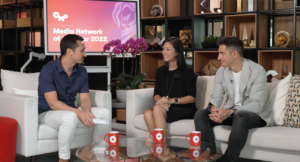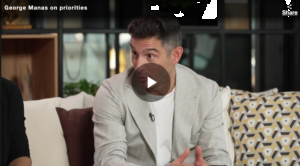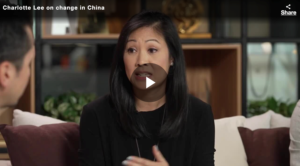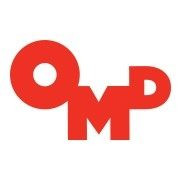Originally published in Campaign Asia.
Business transformation services, digital and performance marketing, developing talent and applying Asian innovation are all areas of focus, say its global and APAC CEOs.
George Manas, global CEO, OMD; Charlotte Lee, APAC CEO, OMD Less than a year into their respective roles leading Omnicom’s largest media agency globally and regionally, George Manas and Charlotte Lee sat down with Campaign Asia-Pacific to discuss their challenges, priorities and vision for the business.
The OMD chief executives say they want to focus on becoming more of a transformational agency helping brands meet their data and technology needs and less of a transactional firm executing straight media-buying and planning services.
Below is a transcript of the conversation, edited for brevity and clarity.

What have your priorities been so far in your new roles? Where have you been able to move the needle–or expect to–shortly?
George Manas, global CEO, OMD: Coming out of this pandemic, people’s lives have gotten more complex and so has marketing to them. Our clients’ needs have evolved pretty rapidly over the course of the last 24 months.
We’re focused on three key areas. One is business transformation. How could we be the most trusted partner to clients as they look to pivot more to digital or to ecommerce in their business model. The second one is digital leadership. We’re the single largest digital agency globally and we feel like we have a responsibility to not just be capable in digital, but to lead the industry forward in new and next ways and we’re delivering that through Omni, our underlying data and technology platform. The third priority for us is all about talent. How do we attract, retain and develop the next generation of leadership, not just in media but in marketing? Those are my three ambitions and obsessions for the team overall.
Charlotte Lee, APAC CEO, OMD: Of course our priorities are in line with the global ambition that George outlined: Digital leadership, being business transformation partners for our clients, and talent. But we are also focusing on bringing together the power of our network through the strength of our local markets. We have incredible success in our network in markets such as Australia, New Zealand, and Singapore, so we think there’s opportunity for us to elevate the overall region by harnessing the strength of our markets more broadly.

What are the biggest challenges facing media agencies right now?
GM: For me the biggest challenge is that media agencies can get so mired in the transactional that it’s really about how we get our heads up and deliver on the transformational work for clients. As we come out of the pandemic it’s about elevating the conversation with our clients. Agencies are by definition consultative [but] it’s about doing this on a different level and scale now and meeting our clients where their needs are in those critical areas of growth like ecommerce, data and technology consultancy.
CL: We need to also make sure that we have the right people in in place to be able to have these conversations and lead these conversations with our clients so that they can focus on the business as a whole rather than just the traditional sort of media side of things which we may have just focussed on before.
What’s the future of performance marketing as it relates to media agencies? Many holding companies have separate units [but the main media] agencies also are very engaged in it. So where does it sit right now in an agency like OMD and is it going to be more integrated?
GM: My background is in performance marketing and I see all media through a performance lens. Media must be accountable to bottom line business results, and for me performance media is really just the application of data and technology to make media perform better against those KPIs. So when we look at performance we’re thinking about it through a truly full-funnel holistic consumer journey and that’s critically important.
I don’t think you get there with fragmented service solutions so we’re really proud as OMD to have deep performance capability and talent integrated into the business so that we can deliver on that full-funnel end-to-end promise to our clients. We also have Omni which is that end-to-end solution for us that helps our teams move through audience planning to tactical channel planning to measurement optimisation and more. So it’s really an enabler for us to get more of our teams thinking more performance-oriented about the media plan. Even if that means TV, because through data and technology, TV can start to behave more like an accountable performance channel. So it’s really about bringing that performance spirit and mindset to all of our teams so that we can deliver better decisions, faster.
A lot of industry talk on talent in the past year has been around retention schemes and trying to get the younger generations excited again. What do you do to engage that younger generation at media agencies and tell them they won’t be just a cog in a machine?
GM: Our ambition is to move people from thinking about jobs and media to careers. Our biggest asset is our clients, so we work with some of them the world’s most recognised and exciting brands and that creates such opportunity for the next generation because they’re helping those brands pivot into digital, into influence, or into creators. At its root is our ability to provide talent with access to brands like Apple, State Farm and Home Depot in the US, and Clorox. So it’s a brilliant opportunity for those who want to fast-track a career where the rubber is really hitting the road.
CL: I also think it’s really important to look at the culture piece as well, especially coming back from the pandemic where people have not been together for a long time. [It’s about] creating that environment where people feel they have a sense of belonging that helps us to retain people in the long run, so they feel like they have a home and a career rather than just a job.
In Asia Pacific, where are the areas in specific markets or channels where you expect OMD’s growth to come from?
CL: We’re looking at all sides of it. We’re looking at markets, we’re looking at where we’ve got the opportunity to grow, where we aren’t number one already and where there is room [for growth]. We’re looking at our client base and portfolio to see what types of [new] clients and categories will help to complement them. But we’re also looking at our organic growth from our existing client base and what diversified services we can offer them to grow and transform their business, like ecommerce. We’re looking at all angles and I think that’s the exciting part about being in this region. There is such growth opportunity for us within the network.
From a global perspective, are you focused on regions and sub regions or is that less important now [compared to] lines of business?
GM: It’s everything frankly. I tend to look at the business as if I were a retailer. There’s a geographic element to it, we know in APAC we’re really bullish on growth [with] some real opportunities to accelerate here. I look at products, diversification of our revenue streams and we’ve been quite good at moving into ecommerce, digital and data consultancy beyond traditional media-planning and -buying service remits. Our scopes of work look very different than they have historically. Then we also look at clients. We’ve got a a wonderfully diverse portfolio but we’re always looking to see where we could best partner with industries or verticals. So it’s a three-legged stool: Geography, clients and product.
[What has] surprised you from markets outside of the US or in Asia Pacific? Can you take some learnings and apply them elsewhere?
GM: We’ve got a huge opportunity to continue to look at APAC for innovation and it’s certainly high on my agenda relative to ecommerce and metaverse. We know we know that most of that innovation is actually happening in the East and then manifesting itself in Europe, North America and Latin America so as a network one of our advantages is to look at how to create more innovation and accelerate those capabilities from APAC into our other markets. It [also] goes both ways. Creating those connection points more fluidly, not just in APAC but globally is a huge priority for us.
CL: From an innovation standpoint, China is a perfect example of where we really look to China as a beta office where we can test and build to be adapted for the rest of the world. China is typically at the forefront of the future, so leveraging some of those tests in that market allows us to scale that rather than trying to retrofit something developed in the West for China.

There’s been a lot of change in China in recent years, not only with the constantly evolving digital ecosystem but also in geopolitical dynamics. We’re seeing differences in the relationship between international brands and that consumer market, how [Chinese] consumers feel towards its own brands and how those brands expand abroad. How does all of this affect your business in China?
CL: China obviously is going through big changes and we’ve made some changes as well having [OMD China CEO Connie Chan there] to help us to be more future-facing. But geopolitics has a huge impact on brands. The recent Better Cotton Initiative (BCI) boycott is an example of where it is taking brands 18 months plus to really bounce back from that. And Chinese brands advertising outside of China are also sometimes having to distance themselves a little bit from their Chinese origin just to avoid some of those new political sensitivities.
The other side is for global brands advertising in China that really need to be sensitive about cultural relevance and localisation. That has always been [the case], but now it’s taken to the next level. It’s not just about having Asian faces and not just about the translation of language but it’s really about resonating from a consumer tension point of view. The last thing which you touched on already is about the platforms and the change in the digital ecosystem. It’s really important for global brands to keep up with what’s happening on those platforms because [they’re] constantly evolving with different formats and opportunities. Global brands need to be able to harness that and use them in a way that [allows them to] stay relevant and local.
